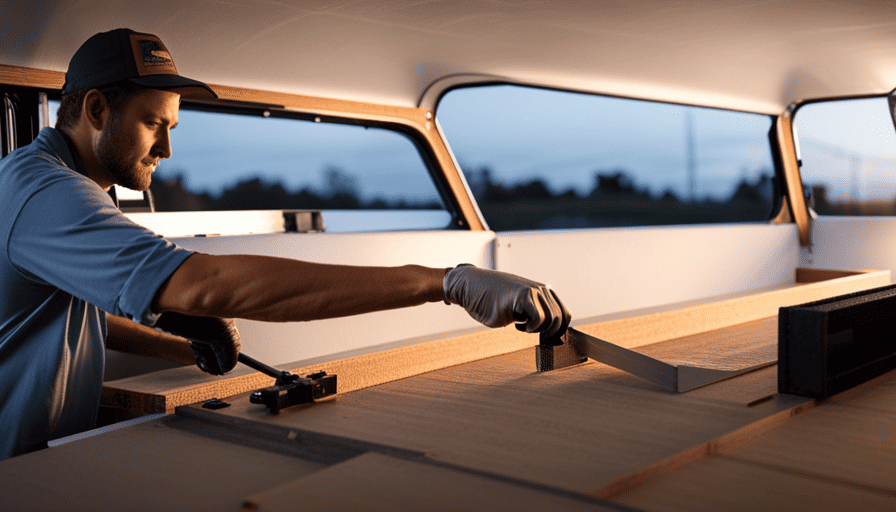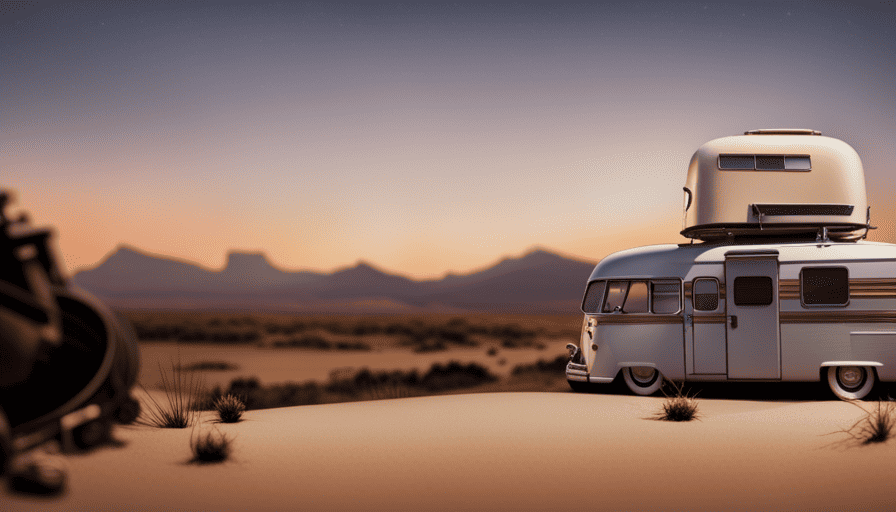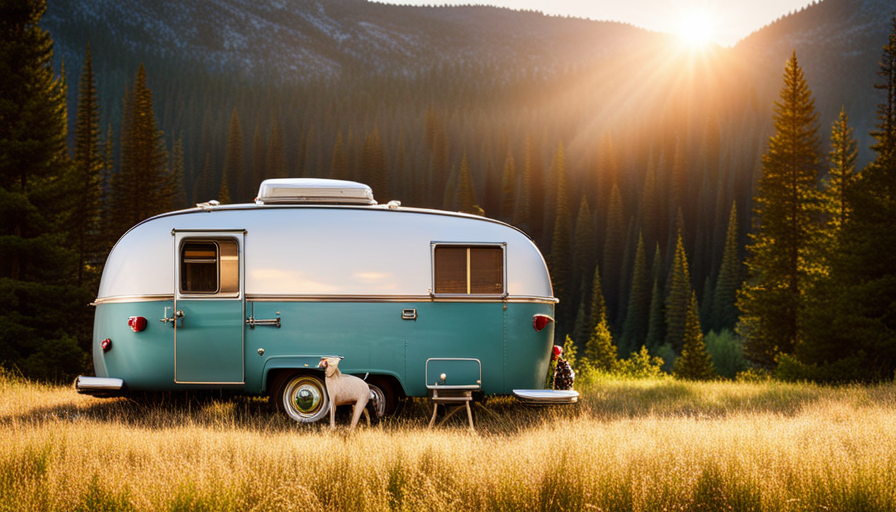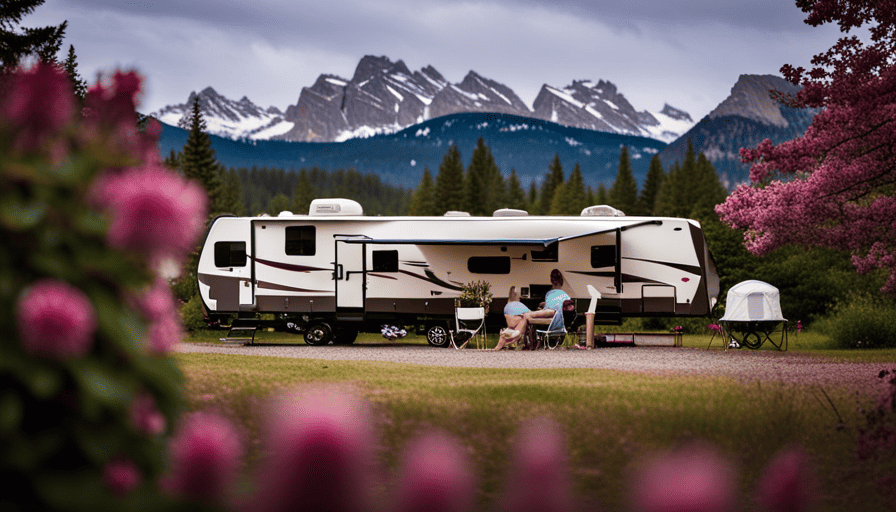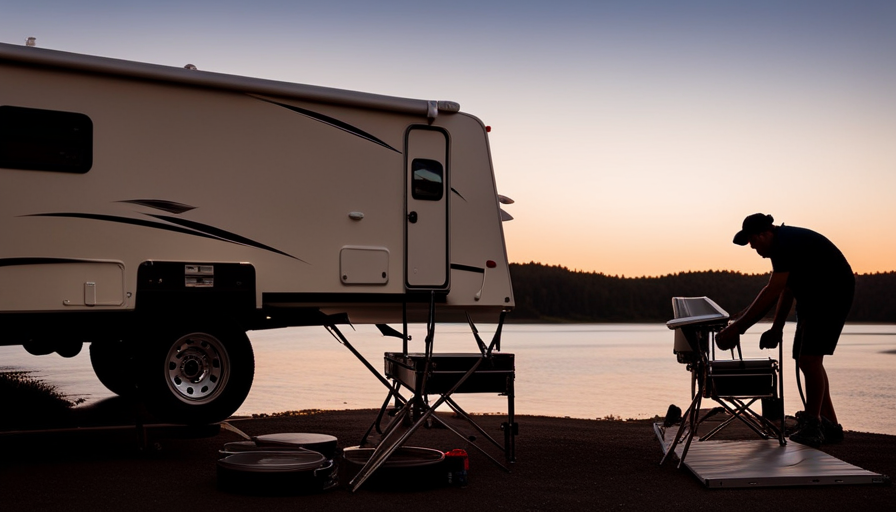Ever fantasized about embarking on an adventure, discovering new locales, and sleeping beneath the starlit sky? I have the perfect answer for you! In this article, I’ll walk you through the detailed steps required to construct your personal truck bed camper.
Picture yourself cruising down the highway, with all the comforts of home right in the back of your trusty truck.
Now, I know what you’re thinking – building a camper sounds like a daunting task. But fear not! With a little determination and some handy tools, you’ll be amazed at what you can create.
From assessing your truck’s compatibility to adding personal touches, I’ll walk you through every stage of the construction process. Get ready to unleash your creativity and turn your truck into the ultimate adventure-mobile.
So, buckle up and get ready for an exhilarating journey. It’s time to dive into the world of DIY truck bed campers and create a home on wheels that’s uniquely yours.
Let’s get started!
Key Takeaways
- Assess truck bed compatibility and make necessary modifications
- Choose camper accessories and plan the layout of the camper
- Gather necessary materials and tools for construction
- Consider different materials for camper walls and roofs, and prioritize insulation and weight
Assess Your Truck and Determine Compatibility
Assess your truck and figure out if it’s compatible for building a truck bed camper. Before diving into the project, it’s crucial to evaluate your truck’s specifications and determine if any modifications are necessary.
Start by measuring the dimensions of your truck bed, noting the length, width, and height. Consider the weight capacity of your truck and ensure it can handle the extra load of a camper.
Next, examine the condition of your truck bed. Look for any signs of rust, damage, or weak spots that may need to be addressed before proceeding. It’s essential to have a sturdy and reliable foundation for your camper.
Once you’ve assessed your truck, it’s time to think about the necessary modifications. Depending on the type of camper you want to build, you may need to make adjustments to the truck bed. This can include installing tie-down points, reinforcing the bed with additional support, or adding storage compartments.
Additionally, consider the truck bed camper accessories you’ll need for a comfortable and functional setup. This may include a camper shell, roof racks, awnings, or even a rooftop tent. Research and choose accessories that suit your needs and preferences.
With your truck bed modifications and camper accessories in place, you’re ready to move on to the next step: planning and designing your camper layout.
Plan and Design Your Camper Layout
Imagine yourself nestled in a cozy space, carefully considering the layout of your dream mobile sanctuary. As you plan and design your camper layout, there are a plethora of camper decorating ideas and interior design tips to consider. The key is to create a space that maximizes functionality and comfort, while also reflecting your personal style.
Firstly, think about the different areas you want to include in your camper. Will you have a sleeping area, a kitchenette, a dining space, or a bathroom? Consider the dimensions of your truck bed and how you can utilize the space efficiently. One innovative idea is to incorporate convertible furniture, such as a sofa that can transform into a bed or a table that can fold away when not in use.
When it comes to camper decorating ideas, think about the colors, textures, and materials that will create a warm and inviting atmosphere. Consider using lightweight and durable materials that can withstand the rigors of travel. You can also personalize your camper with decorative accents, such as throw pillows, curtains, and wall art.
Transitioning into the subsequent section about gathering materials and tools needed for construction, it’s important to plan meticulously to bring your camper layout to life.
Gather Materials and Tools Needed for Construction
Get ready to gather all the materials and tools you’ll need to bring your dream mobile sanctuary to life. When choosing the right materials for your truck bed camper, it’s important to consider durability, cost, and weight. Opt for sturdy materials like plywood or aluminum for the walls and roof, ensuring they can withstand the rigors of the road.
Additionally, consider the weight of the materials as it’ll affect your vehicle’s performance and fuel efficiency.
Next, it’s time to find the necessary tools and equipment for construction. You’ll need a variety of tools such as a circular saw, drill, tape measure, and level to ensure precision and accuracy during the building process. Don’t forget to gather safety equipment like gloves, goggles, and a dust mask to protect yourself during construction.
With all the materials and tools in hand, you’re now ready to move on to the next step and build the base and frame of your camper. By following the proper techniques and using the right materials, you’ll be well on your way to creating a sturdy and comfortable foundation for your truck bed camper.
Build the Base and Frame of Your Camper
Now, it’s time to roll up your sleeves and start constructing the sturdy foundation that’ll transform your truck into the ultimate mobile sanctuary.
The first step in building the base and frame of your camper is to measure your truck bed dimensions. This’ll ensure a perfect fit and optimal use of space.
Once you have the measurements, gather your materials and tools, including plywood, 2x4s, screws, and a saw.
To begin, cut the plywood to match the dimensions of your truck bed. This’ll serve as the base of your camper.
Next, construct the frame using the 2x4s. Make sure to distribute the weight evenly to maintain stability while on the road. Attach the frame to the plywood base using screws for added strength.
Now, let’s talk about weight distribution. It’s crucial to distribute the weight evenly throughout the camper to prevent any issues while driving. Consider placing heavier items near the center of the camper, with lighter items towards the edges.
With the base and frame complete, you’re ready to move on to the next step: installing insulation and flooring for comfort.
Install Insulation and Flooring for Comfort
Let’s dive into the next step and make your mobile sanctuary even more comfortable by installing insulation and flooring. When it comes to insulation options, there are a few to consider. The two most common types are foam board insulation and spray foam insulation. Foam board insulation is relatively easy to install and provides good thermal resistance. On the other hand, spray foam insulation offers superior insulation properties and can fill in any gaps or cracks, providing a more airtight seal.
To give you a better idea, here’s a table comparing the two insulation options:
| Insulation Option | Pros | Cons |
|---|---|---|
| Foam Board | Easy to install | May not provide a completely airtight seal |
| Spray Foam | Superior insulation properties | Requires professional installation |
Moving on to flooring materials, there are several options as well. One popular choice is plywood, which is durable and cost-effective. Another option is vinyl flooring, which is water-resistant and easy to clean. Finally, for a more luxurious feel, you can opt for hardwood flooring, although it may be more expensive and require more maintenance.
With insulation and flooring in place, your camper will be well-insulated and comfortable. Next, we will move on to the construction of walls and roof for added structure and protection.
Construct Walls and Roof for Structure and Protection
After ensuring insulation and flooring are in place, it’s time to fortify your mobile sanctuary by constructing sturdy walls and a roof for added structure and protection.
When it comes to wall and roof construction techniques for a truck bed camper, there are several options to consider. One popular method is using wooden frames, which provide stability and can easily be customized to fit your specific needs.
Another option is using aluminum or fiberglass panels, which are lightweight yet durable. Additionally, some campers prefer using composite materials like fiberglass reinforced plastic (FRP) or high-density polyethylene (HDPE) for their walls and roofs, as they offer excellent insulation properties and are resistant to moisture and UV rays.
When selecting materials for your camper walls and roofs, it’s important to prioritize durability, weight, and insulation. Wood is a cost-effective choice that provides good insulation, but it can be heavy. Aluminum and fiberglass panels are lightweight and offer decent insulation, but they may not be as durable as wood. Composite materials like FRP and HDPE are lightweight, durable, and provide excellent insulation, making them a popular choice among camper builders.
As you complete the construction of your walls and roof, the next step is to install windows, doors, and ventilation for airflow.
Install Windows, Doors, and Ventilation for Airflow
To enhance air circulation within your mobile sanctuary, it’s crucial to install windows, doors, and ventilation for optimal airflow. When it comes to window placement, strategic positioning is key. Consider installing windows on opposite sides of the camper to create a cross breeze effect. This will allow fresh air to flow in from one window while stale air exits through the other. Additionally, placing windows higher on the walls rather than lower can help maintain privacy while still allowing for airflow.
When choosing the right door for your truck bed camper, durability and functionality should be top priorities. Opt for a door that is weather-resistant and secure, as it will provide protection against the elements and potential intruders. Consider installing a screen door as well, to keep insects out while still allowing fresh air to circulate.
In terms of ventilation, incorporating a roof vent is essential. This will help to remove moisture, odors, and heat from the interior. Choose a vent with a fan to enhance airflow even further. Additionally, installing a small vent or two on the side walls can provide additional ventilation options.
To transition into the subsequent section about building furniture and storage solutions for functionality, it’s important to consider how proper airflow can positively impact the overall comfort and livability of your truck bed camper. With windows, doors, and ventilation in place, you can now focus on creating a functional and inviting space by incorporating furniture and storage solutions.
Build Furniture and Storage Solutions for Functionality
Create a cozy and efficient living space by designing and incorporating furniture and storage solutions that maximize functionality in your mobile sanctuary.
When it comes to furniture organization, it’s essential to prioritize space optimization in a truck bed camper. Start by selecting multi-purpose furniture pieces that can serve multiple functions to make the most out of limited space. Consider installing a foldable table that can be used both for dining and as a workspace. Additionally, utilize built-in storage solutions such as under-bed drawers and overhead cabinets to keep your belongings organized and easily accessible.
To further optimize space, think vertically. Install wall-mounted shelves or hanging organizers to make use of vertical space for storing smaller items like kitchen utensils or toiletries. Utilizing hooks or magnetic strips can also help to maximize storage options by providing a place to hang items like hats or keys.
When designing the furniture layout, consider creating a seating area that can double as a sleeping space. This can be achieved by installing a bench with storage underneath that can be converted into a bed at night.
By incorporating these innovative furniture and storage solutions, you can make the most out of your truck bed camper’s limited space while still ensuring comfort and functionality.
Transitioning into the subsequent section about ‘install electrical and plumbing systems for convenience,’ it’s crucial to consider these systems to enhance the overall functionality and convenience of your mobile sanctuary.
Install Electrical and Plumbing Systems for Convenience
Enhance the functionality and convenience of your mobile sanctuary by installing electrical and plumbing systems, allowing you to enjoy the comforts of home on the road. Here are four essential steps to ensure electrical safety and plumbing maintenance in your truck bed camper:
-
Electrical Safety:
- Begin by installing a power distribution panel to manage and distribute electricity safely.
- Use a deep cycle battery to provide power when not connected to an external source.
- Install circuit breakers to protect against electrical overloads.
- Incorporate grounding techniques to prevent electrical shocks and fires.
-
Plumbing Maintenance:
- Start by installing a freshwater tank and a water pump for a reliable water supply.
- Use food-grade hoses and connectors to ensure safe water consumption.
- Install a water heater to enjoy hot showers and warm water for cooking.
- Incorporate a greywater tank to collect and dispose of wastewater responsibly.
By following these steps, you can have peace of mind knowing that your electrical and plumbing systems are safe and efficient. Now, let’s explore how to add personal touches and decor to make your truck bed camper feel like home.
Add Personal Touches and Decor to Make it Feel Like Home
Adding personal touches and decor to my mobile sanctuary has transformed it into a cozy and inviting space that truly feels like home. Personalizing the interior of my truck bed camper has allowed me to express my unique style and create a comfortable living environment.
One of the first steps in personalizing the interior is choosing the right color scheme. I opted for a calming neutral palette with pops of vibrant colors to create a visually pleasing and relaxing atmosphere.
To add a touch of innovation, I installed LED strip lights along the walls and ceiling. These lights not only provide functional lighting but also create a warm and cozy ambiance. Additionally, I incorporated innovative storage solutions to maximize space and keep everything organized. I installed floating shelves, hanging baskets, and storage bins to keep my belongings easily accessible and prevent clutter.
To make it feel more like home, I added personal photographs, artwork, and decorative accents that reflect my personality and interests. I also invested in comfortable bedding, pillows, and curtains to enhance the coziness factor. Lastly, I incorporated plants and greenery to bring a breath of fresh air into my mobile sanctuary.
By personalizing the interior and choosing the right color scheme, my truck bed camper has been transformed into a warm, inviting, and uniquely styled home on wheels.
Frequently Asked Questions
How much does it cost to build a truck bed camper?
Well, let me tell you, building a truck bed camper can be quite the adventure. And when it comes to cost, it’s a real nail-biter.
You see, the beauty of DIY is that you can save a pretty penny compared to buying one ready-made. But here’s the kicker: the final cost really depends on your skills, materials, and the level of innovation you bring to the table.
So, buckle up and let’s dive into this cost comparison, shall we?
How long does it typically take to build a truck bed camper?
Typically, it takes several weeks to plan for and build a truck bed camper. To streamline the process, start by researching different camper designs and selecting one that suits your needs.
Next, gather the necessary materials and tools. Ensure you have proper measurements to customize the camper to fit your truck bed. Consider adding innovative features like solar panels or a storage system.
Proper planning and attention to detail will result in a successful camper build.
Can I use any type of truck to build a camper?
Yes, it’s possible to use any type of truck to build a camper. However, it’s important to consider the compatibility of the truck bed camper with the specific truck model.
Different trucks may have different size restrictions, so it’s crucial to ensure that the camper fits properly on the truck bed. This will ensure stability and safety while traveling.
It’s recommended to consult the truck bed camper manufacturer or a professional for guidance on compatibility and size restrictions.
What are the weight restrictions for a truck bed camper?
Alright folks, let’s dive into the weight restrictions for a truck bed camper.
Now, when it comes to truck bed camper design, weight is a crucial factor to consider. The pros of a truck bed camper include portability and versatility. However, there are cons as well, such as limited living space.
Now, back to the weight restrictions. It really depends on the specific truck model, but generally, you should aim for a camper that doesn’t exceed the truck’s payload capacity to ensure optimal safety and performance.
Are there any legal requirements or regulations for using a truck bed camper?
When it comes to using a truck bed camper, there are certain legal requirements and regulations that need to be followed.
One important aspect is truck bed camper insurance, which is necessary to protect yourself and your vehicle.
Additionally, there are safety regulations for truck bed campers that must be adhered to ensure the well-being of both the occupants and other road users. These regulations typically cover areas such as weight limits, proper securing of the camper, and safety equipment requirements.
What Are the Similarities and Differences Between Building a Van Camper and a Truck Bed Camper?
When it comes to build your own van camper or a truck bed camper, there are several similarities and differences to consider. Both options provide a mobile living space, but the vehicle size and layout vary. Van campers offer more interior space and amenities, while truck bed campers are more compact and easier to maneuver. Additionally, van campers can often accommodate larger groups, while truck bed campers are ideal for solo or duo adventurers seeking simplicity. The choice ultimately depends on personal preferences and specific travel needs.
Conclusion
As I’m putting the finishing touches on my truck bed camper, I can’t help but feel a sense of pride and accomplishment.
The hours of planning, designing, and building have all led up to this moment.
As I step back and take in the sight of my creation, I’m filled with excitement for the adventures that lie ahead.
The thought of hitting the open road, with my cozy and functional camper in tow, ignites a sense of wanderlust within me.
I can already envision the breathtaking landscapes, the nights spent under the stars, and the memories that’ll be made.
With my truck bed camper, the possibilities are endless, and I’m ready to embark on the journey of a lifetime.

